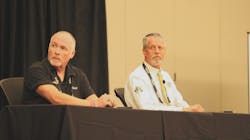ST. LOUIS — Boyle Transportation hasn’t had a catastrophic incident in over a decade, according to Michael Lasko, the trucking company’s manager of safety and quality. That’s partly because the carrier specs its fleet with safety technologies like forward-looking radar, blind spot radar, lane departure warning systems, roll stability on both tractors and trailers, and cameras that look down both sides of its tractors.
Unfortunately, it was a tragic event that prompted Boyle to implement these systems, Lasko pointed out during a Truckload Carriers Association Safety & Security Meeting panel on truck safety technologies.
“We lost a professional driver team in a rollover, and we were never able to determine if it was a fatigue-related matter or a medical crisis, but it really hit home in the company,” Lasko explained. “We were a much smaller company back then, and these were highly regarded members of our team.”
Today, as the company continues to adopt new technologies, Lasko emphasized the importance of getting driver buy-in from the start and involving drivers in the decision-making process as much as possible.
In addition to driver input, Boyle evaluates its products and the issues at hand, say rear-end collisions or sideswipes, that need to be addressed. Lasko noted that the company then tries to come up with a package of safety technologies that complement each other. The company also utilizes video event recorders to be more proactive than reactive and coach drivers as incidents happen.
Rick Schmidt, director of HR and safety at Nussbaum Transportation, is constantly looking at new safety technologies and testing them with drivers. The carrier currently specs roll stability, collision mitigation, inward- and outward-facing event recorders, and blind spot detection within its fleet of 460 trucks. Nussbaum also has a six-year procurement cycle, so the fleet’s oldest truck right now is a 2016.
During a separate panel at the meeting, Nussbaum Transportation company driver and trainer Clark Reed emphasized the importance of proper driver training when it comes to truck technology.
“If you don’t teach people how to manage this technology, it takes away from the driver a little bit,” Reed said. “Learning how to manage this technology is key to making it efficient and safe.”
Reed tests new safety equipment and technology for Nussbaum and informs the company when something will work and when it won’t.
Like Lasko, Schmidt also stressed the importance of getting driver input before implementing any new technology. The company added inward- and outward-facing cameras eight years ago but didn’t lose one driver because of thorough testing.
“We tested it with a few drivers, and it wasn't just our best drivers, it was the ones that we knew would push back and find the loopholes, the ones who really did not like an inward-facing camera going on them,” Schmidt explained. “We did that because we're able to get true and honest feedback.
“You can have the best safety system out there, but if you don't have the buy-in from your drivers, it's not going to do anything for you,” he added.
Training from the driver’s seat
Technology is developing rapidly, and trucking companies are continuing to implement and spec their vehicles with systems to keep their assets safe. But for the commercial vehicle operator, safety system alerts and in-cab cameras can be distracting and might seem like technology is taking over how they do their jobs.
Rather than teaching drivers to depend on a truck’s safety technology, Albert tries to show his students what the technology is looking for.
“I teach them to see what it sees when they are looking out of the same windshield,” Albert said. “The key is to stay a step ahead of it. Train the driver on what it’s looking for, but don’t tell them that it’s all figured out. It’s not all figured out; it does need their assistance.”
Albert added that so much of the industry-wide conversation about technology is how smart today’s commercial vehicles are. However, drivers at a truck stop are quick to tell him how “stupid” the trucks are.
“These trucks are not at all smart, and they are not at all stupid,” Albert explained. “They’re just computers, and computers are not smart or stupid. They are operating on logic. So, that’s really what I train [drivers] on—what’s the logic behind the system?
“Once they understand the logic, they can stay a step ahead of it, and it makes them a better driver,” he continued. “Then, they keep the system in the background to save their career and/or someone’s life.”
One thing that Reed says he always tells his student is to leave enough space between vehicles—about 100 ft—to avoid a hard braking event.
When it comes to collision mitigation technology like ABS to prevent jackknifing of the trailer during emergency braking, the technology has absolutely helped reduce crashes. However, Albert noted that human nature will cause people to drive right up to the technology’s limit.
“To me, the real key is to not use your safety systems,” he said. “Don’t drive up to that new limit. That’s human nature, though, especially when you’re paid by the mile.”
Reed emphasized that getting driver buy-in on new technology can be incredibly challenging because drivers are paid by the mile yet regulated by the hour.
“That puts us in a bad situation where we have to go, go, go to make money, but we’ve got to fight this clock, and we want to be safe,” he said.
Reed also suggested that some drivers aren’t as receptive to new safety technologies because they can sometimes take away “the feel of the truck.”
“The driver really needs to feel the road,” he advised. “The moment you take the driver away from that experience, the more they are going to relax and become lackadaisical in their driving, and that’s what leads to accidents.”
Boyle Transportation’s Lasko pointed out that it’s up to the company to provide adequate training on the systems that are in the truck, otherwise drivers could develop misconceptions that spread throughout the organization. He said Boyle does hands-on training with every driver before they get into the truck by going through every system, how it functions, what alerts mean, and ways settings can be customized. In addition, the company uses an online learning management system in which it has uploaded custom training content made available to the drivers.
Lasko added that another important piece of training that often gets overlooked is training the maintenance staff to understand how these safety systems function.
Future trends
When it comes to new safety technology on the horizon, Len Copeland, product marketing manager at Daimler Trucks North America, pointed to connected vehicle safety and systems communicating with one another.
“It's a march toward semi-autonomous vehicles that will fully assist and protect the driver,” Copeland explained. “Let's not forget the best safety system we have is an attentive driver. In my lifetime, I don't see that going away. These systems really are about assisting the driver, reducing tasks that the driver has, and keeping his or her attention on the road.”
Here’s Copeland’s short list of technologies that fleets can watch out for:
Mirror cams to replace side mirrors: The cameras will move and look at the side of the trailer and at the end of the trailer doors rather than a mirror facing into the side of the trailer. Copeland said this will eliminate any visibility issues and will reduce aerodynamic drag, allowing fleets to pick up a nearly 1% fuel economy gain.
Environment cameras: Full 360-degree cameras could help fleets locate their vehicles and can be used to help exonerate drivers during litigation, he noted.
Blind spot warning with braking: Blind spot assists and side radar anticipate a collision or sideswipe, automatically applying the brake for the driver.
Cross-traffic assist mitigation: This is an algorithm that analyzes the position of all vehicles around it—velocity, size, behavior of vehicles, etc., to determine whether the truck has to yield or has the right way.
About the Author

Cristina Commendatore
Cristina Commendatore is a past FleetOwner editor-in-chief. She wrote for the publication from 2015 to 2023.

